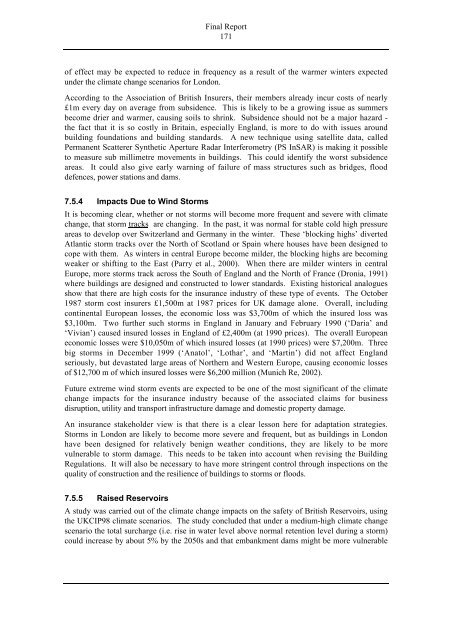London scoping - ukcip
London scoping - ukcip
London scoping - ukcip
Create successful ePaper yourself
Turn your PDF publications into a flip-book with our unique Google optimized e-Paper software.
Final Report<br />
171<br />
of effect may be expected to reduce in frequency as a result of the warmer winters expected<br />
under the climate change scenarios for <strong>London</strong>.<br />
According to the Association of British Insurers, their members already incur costs of nearly<br />
£1m every day on average from subsidence. This is likely to be a growing issue as summers<br />
become drier and warmer, causing soils to shrink. Subsidence should not be a major hazard -<br />
the fact that it is so costly in Britain, especially England, is more to do with issues around<br />
building foundations and building standards. A new technique using satellite data, called<br />
Permanent Scatterer Synthetic Aperture Radar Interferometry (PS InSAR) is making it possible<br />
to measure sub millimetre movements in buildings. This could identify the worst subsidence<br />
areas. It could also give early warning of failure of mass structures such as bridges, flood<br />
defences, power stations and dams.<br />
7.5.4 Impacts Due to Wind Storms<br />
It is becoming clear, whether or not storms will become more frequent and severe with climate<br />
change, that storm tracks are changing. In the past, it was normal for stable cold high pressure<br />
areas to develop over Switzerland and Germany in the winter. These ‘blocking highs’ diverted<br />
Atlantic storm tracks over the North of Scotland or Spain where houses have been designed to<br />
cope with them. As winters in central Europe become milder, the blocking highs are becoming<br />
weaker or shifting to the East (Parry et al., 2000). When there are milder winters in central<br />
Europe, more storms track across the South of England and the North of France (Dronia, 1991)<br />
where buildings are designed and constructed to lower standards. Existing historical analogues<br />
show that there are high costs for the insurance industry of these type of events. The October<br />
1987 storm cost insurers £1,500m at 1987 prices for UK damage alone. Overall, including<br />
continental European losses, the economic loss was $3,700m of which the insured loss was<br />
$3,100m. Two further such storms in England in January and February 1990 (‘Daria’ and<br />
‘Vivian’) caused insured losses in England of £2,400m (at 1990 prices). The overall European<br />
economic losses were $10,050m of which insured losses (at 1990 prices) were $7,200m. Three<br />
big storms in December 1999 (‘Anatol’, ‘Lothar’, and ‘Martin’) did not affect England<br />
seriously, but devastated large areas of Northern and Western Europe, causing economic losses<br />
of $12,700 m of which insured losses were $6,200 million (Munich Re, 2002).<br />
Future extreme wind storm events are expected to be one of the most significant of the climate<br />
change impacts for the insurance industry because of the associated claims for business<br />
disruption, utility and transport infrastructure damage and domestic property damage.<br />
An insurance stakeholder view is that there is a clear lesson here for adaptation strategies.<br />
Storms in <strong>London</strong> are likely to become more severe and frequent, but as buildings in <strong>London</strong><br />
have been designed for relatively benign weather conditions, they are likely to be more<br />
vulnerable to storm damage. This needs to be taken into account when revising the Building<br />
Regulations. It will also be necessary to have more stringent control through inspections on the<br />
quality of construction and the resilience of buildings to storms or floods.<br />
7.5.5 Raised Reservoirs<br />
A study was carried out of the climate change impacts on the safety of British Reservoirs, using<br />
the UKCIP98 climate scenarios. The study concluded that under a medium-high climate change<br />
scenario the total surcharge (i.e. rise in water level above normal retention level during a storm)<br />
could increase by about 5% by the 2050s and that embankment dams might be more vulnerable

















